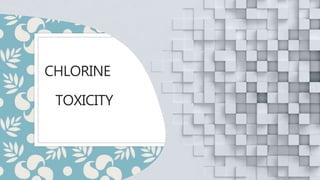Chlorine gas is a pulmonary irritant that causes acute damage to the upper and lower respiratory tract. It has been used as a chemical weapon and is still involved in some attacks. Exposure to chlorine gas leads to inflammation of the airways and lungs and can cause pulmonary edema. Symptoms range from irritation to death depending on concentration. Treatment involves oxygen, fluids, bronchodilators, and corticosteroids. High risk patients may require hospitalization for monitoring due to risk of respiratory failure.

![Background
◦ Chlorine gas is a pulmonary irritant with intermediate water solubility that causes acute damage in the upper
and lower respiratory tract.
◦ Currently, occupational exposures constitute the highest risk for serious toxicity from high-concentration
chlorine.
◦ Mixing of chlorine bleach (sodium hypochlorite) with ammonia or acidic cleaning agents is a common source
of household exposure.
◦ Chlorine gas has also been used repeatedly as a chemical weapon. [3]
◦ An estimated 93,800 tons of chlorine gas was produced during World War I, with more than half produced by
Germany.
◦ Chlorine was abandoned as a warfare agent when the use of gas masks was introduced and more effective
compounds were created and deployed.
◦ However, on at least three occasions in January and February 2007, insurgents in Iraq incorporated chlorine
tanks in vehicle-borne improvised explosive device (VBIED) attacks. Most of the deaths from the attacks were
caused by the explosion, but many people were treated and hospitalized for chlorine exposure. [5]
◦ The Organization for the Prohibition of Chemical Weapons (OPCW) has confirmed that since 2013, chlorine
gas has been the agent used in numberous chemical attacks in Syria affecting thousands of civilians and
[3]](https://image.slidesharecdn.com/chlorine-201106224330/85/Chlorine-Toxicity-2-320.jpg)
![Pathophysiology
◦ Chlorine is a greenish-yellow
◦ Prolonged exposure to chlorine gas may occur because its moderate
water solubility delays onset of upper airway symptoms for several
minutes. In addition, chlorine gas is heavier than air in its pure form,
causing it to remain near ground level and increasing exposure time.
◦ As the concentration of chlorine gas exposure increases, the severity of
symptoms and rapidity of onset increase. The IDHL (immediately
dangerous to life or health) is 10 ppm.
◦ Concentrations above 400 ppm are often fatal. [7]](https://image.slidesharecdn.com/chlorine-201106224330/85/Chlorine-Toxicity-3-320.jpg)
![◦ Chlorine is moderately soluble in water and reacts in combination to form hypochlorous (HOCl)
and hydrochloric (HCl) acids. Elemental chlorine and its derivatives, hydrochloric and
hypochlorous acids, may cause biological injury.
◦ The chemical reactions of chlorine combining with water and the subsequent derivative reactions
with HOCl and HCl are as follows:
◦ a1) Cl2 + H2 O ⇔ HCl (hydrochloric acid) + HOCL (hypochlorous acid) or
◦ a2) Cl2 + H2 O ⇔ 2 HCl + [O-] (nascent oxygen)
◦ b) HOCl ⇔ HCl + [O-]
◦ Chlorine gas, when mixed with ammonia, reacts to form chloramine gas. In the presence of water,
chloramines decompose to ammonia and hypochlorous acid or hydrochloric acid. [8]
◦ Because of their high water solubility, chloramine exposures result in rapid symptom
development. However, for mechanistic reasons that are not clear, chlorine 88 nitrogenous
compounds result in less severe symptoms at onset. Because these initial symptoms are often
mild, however, they may not prompt immediate retreat, thus resulting in prolonged exposure, with
pulmonary and ocular symptoms predominating.
◦ Because of its intermediate water solubility and deeper penetration, elemental chlorine frequently
causes acute damage throughout the respiratory tract.](https://image.slidesharecdn.com/chlorine-201106224330/85/Chlorine-Toxicity-4-320.jpg)
![◦ Cellular injury is believed to result from the oxidation of functional groups in cell
components, from reactions with tissue water to form hypochlorous and hydrochloric
acid, and from the generation of free oxygen radicals.
◦ The predominant targets of the acids are the epithelia of the ocular conjunctivae and upper
respiratory mucous membranes.
◦ The immediate effects of chlorine gas toxicity include acute inflammation of the
conjunctivae, nose, pharynx, larynx, trachea, and bronchi. Irritation of the airway mucosa
leads to local edema secondary to active arterial and capillary hyperemia. Plasma
exudation into the alveoli results in pulmonary congestion and edema.
◦ Pathologic findings are nonspecific. They include the following [16] :
• Pulmonary edema
• Pneumonia
• Pneumonitis
• Hyaline membrane formation
• Multiple pulmonary thrombosis
• Ulcerative tracheobronchitis](https://image.slidesharecdn.com/chlorine-201106224330/85/Chlorine-Toxicity-5-320.jpg)
![◦ Dyspnea and Hypoxemia
◦ burns and corneal abrasions have occurred. Acids formed by the chlorine gas
reaction with the conjunctival mucous membranes are partially buffered by the
tear film and the proteins present in tears. Consequently, acid burns to the eye
are typically limited to the epithelial and basement membrane, rarely extending
to the deep endothelial cells.
◦ Acid burns to the periphery of the cornea and conjunctiva often heal
uneventfully. Burns to the center of the cornea may lead to corneal ulcer
formation and subsequent scarring.
◦ Solutions that are able to generate chlorine (eg, sodium hypochlorite bleach)
may cause corrosive injury if ingested. [7]](https://image.slidesharecdn.com/chlorine-201106224330/85/Chlorine-Toxicity-6-320.jpg)







